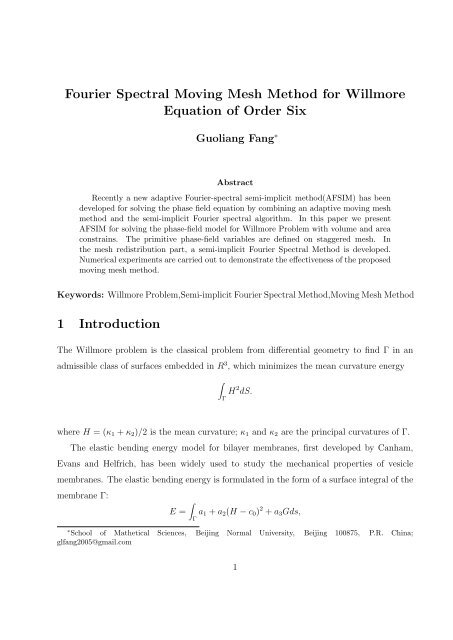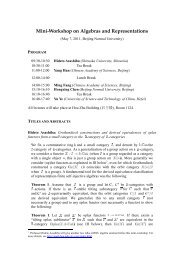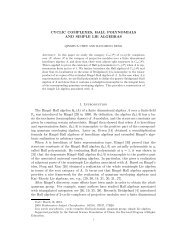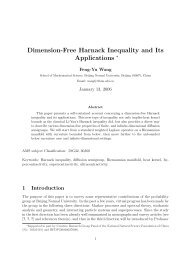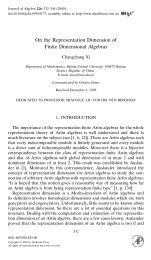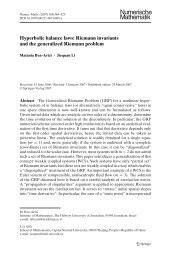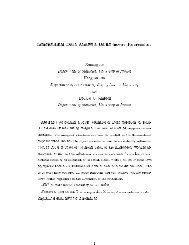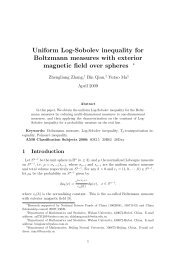Fourier Spectral Moving Mesh Method for Willmore Equation of ...
Fourier Spectral Moving Mesh Method for Willmore Equation of ...
Fourier Spectral Moving Mesh Method for Willmore Equation of ...
Create successful ePaper yourself
Turn your PDF publications into a flip-book with our unique Google optimized e-Paper software.
<strong>Fourier</strong> <strong>Spectral</strong> <strong>Moving</strong> <strong>Mesh</strong> <strong>Method</strong> <strong>for</strong> <strong>Willmore</strong><strong>Equation</strong> <strong>of</strong> Order SixGuoliang Fang ∗AbstractRecently a new adaptive <strong>Fourier</strong>-spectral semi-implicit method(AFSIM) has beendeveloped <strong>for</strong> solving the phase field equation by combining an adaptive moving meshmethod and the semi-implicit <strong>Fourier</strong> spectral algorithm. In this paper we presentAFSIM <strong>for</strong> solving the phase-field model <strong>for</strong> <strong>Willmore</strong> Problem with volume and areaconstrains. The primitive phase-field variables are defined on staggered mesh. Inthe mesh redistribution part, a semi-implicit <strong>Fourier</strong> <strong>Spectral</strong> <strong>Method</strong> is developed.Numerical experiments are carried out to demonstrate the effectiveness <strong>of</strong> the proposedmoving mesh method.Keywords: <strong>Willmore</strong> Problem,Semi-implicit <strong>Fourier</strong> <strong>Spectral</strong> <strong>Method</strong>,<strong>Moving</strong> <strong>Mesh</strong> <strong>Method</strong>1 IntroductionThe <strong>Willmore</strong> problem is the classical problem from differential geometry to find Γ in anadmissible class <strong>of</strong> surfaces embedded in R 3 , which minimizes the mean curvature energy∫ΓH 2 dS.where H = (κ 1 + κ 2 )/2 is the mean curvature; κ 1 and κ 2 are the principal curvatures <strong>of</strong> Γ.The elastic bending energy model <strong>for</strong> bilayer membranes, first developed by Canham,Evans and Helfrich, has been widely used to study the mechanical properties <strong>of</strong> vesiclemembranes. The elastic bending energy is <strong>for</strong>mulated in the <strong>for</strong>m <strong>of</strong> a surface integral <strong>of</strong> themembrane Γ:∫E =Γa 1 + a 2 (H − c 0 ) 2 + a 3 Gds,∗ School <strong>of</strong> Mathetical Sciences, Beijing Normal University, Beijing 100875, P.R. China;glfang2005@gmail.com1
where a 1 represents the surface tension, H = κ 1+κ 22is the mean curvature <strong>of</strong> the membranesurface, with κ 1 and κ 2 as the principle curvatures, and G = κ 1 κ 2 is the Gaussian curvature.a 2 is the bending rigidity and a 3 the stretching rigidity. c 0 is the spontaneous curvaturethat describes the asymmetry effect <strong>of</strong> the membrane or its environment. The equilibriummembrane configurations are the minimizers <strong>of</strong> the energy subject to given surface area andvolume constraints. The simplified case <strong>of</strong>is like the <strong>Willmore</strong> Problem.∫E = (H − c 0 ) 2 ds,ΓPhase field method has been extensively applied to modeling microstructure evolution<strong>for</strong> various materials process such as the mesoscale pattern <strong>for</strong>mation and interface motion.A set <strong>of</strong> spatially dependent field variables are described by the phase function. Particularly,the membrane surface Γ is defined as the zero level set <strong>of</strong> the phase field function φ . Thecorrespondent phase field model is given by [?]∫E(φ) =Γ12ξ (ξ∆φ + (1 ξ φ + c √0 2)(1 − φ 2 )) 2 dxThe surface area and volume constrains can be specified as∫B(φ) =Ω∫A(φ) =Ωφdx = α[ ξ 2 |∇φ|2 + 1 4ξ (φ2 − 1) 2 ]dx = β.Semi-implicit <strong>Fourier</strong>-spectral methods have been employed as an efficient numericalalgorithms <strong>for</strong> phase field simulations. For the reason that this kind <strong>of</strong> method can bothincrease the time step and improve the stability, while achieving high accuracy in space.[?]However, as the width <strong>of</strong> interface ξ in the phase-field model goes to zero, in order tomaintain high resolution, more grid points should be used.On the other hand, uni<strong>for</strong>mgrids are required in order to use FFT algorithm; which results in the high cost <strong>of</strong> numericalcomputation.The studies on adaptive meshing techniques have led to significant improvement <strong>of</strong> thecomputational efficiency <strong>of</strong> traditional fixed grid methods in many applications, includingphase field modeling. It is clear that adaptive mesh methods are useful <strong>for</strong> microstructureswith a very small interfacial width compared to the domain size. .2
Recently, a new adaptive <strong>Fourier</strong>-spectral semi-implicit method(AFSIM) is developedwhich takes advantages <strong>of</strong> both moving mesh method and the Semi-implicit <strong>Fourier</strong> <strong>Spectral</strong>scheme.[?].The work here uses the AFSIM algorithm.And to our best knowledge, <strong>for</strong> the firsttime demonstrate the effectiveness <strong>of</strong> AFSIM <strong>for</strong> solving six-order <strong>Willmore</strong> problem. Sincewe use the gradient flow algorithm <strong>for</strong> the phase-field equations, with two constrains, it isimportant to <strong>for</strong> any algorithm to guarantee the decay <strong>of</strong> energy and the maintenance <strong>of</strong>these constrains. Several numerical examples in this work demonstrate that the AFSIM issatisfactory qualified <strong>for</strong> these requirements.The paper is organized as follows: in section 2, we first review the phase-field equationscorresponding to <strong>Willmore</strong> problems. In section 3, the frame work <strong>for</strong> the MMPDEs, its<strong>Fourier</strong>-<strong>Spectral</strong> implementation will be presented.In section 4, the <strong>Willmore</strong> equationcoupled with MMPDEs and their numerical scheme has been presented. We then presentnumerical simulation results in section5. In section 6, my future plans and problems arepresented. In the the appendix some <strong>for</strong>mulas which kept bothering me has been pro<strong>of</strong>ed.2 Phase field model <strong>for</strong> <strong>Willmore</strong> problemFor simplicity, our phase field model is the variational problem:min E(φ) = κφ∈L∫Ω 2ξ (ξ∆φ + 1 ξ φ(1 − φ2 )) 2 dx (1)with constrains∫B(φ) =∫A(φ) =ΩΩφdx = α, (2)ξ2 |∇φ|2 + 1 4ξ (φ2 − 1) 2 dx = β (3)over the admissible setL = {φ ∈ H 2 | φ| ∂Ω = −1, ∇ · n| ∂Ω = 0} (4)where A(φ) approaches the volume difference between the inside volume and outside volume,and B(φ) approaches to 2 √ 2area(Γ)/3.3
Computationally, it is more convenient to use penalty <strong>for</strong>mulation <strong>for</strong> the two constrains.Denote M 1 , M 2 the two penalty constants, we obtain a modified Elastic bending energyE M (φ) = E(φ) + 1 2 M 1(A(φ) − α) 2 + 1 2 M 2(B(φ) − β) 2 (5)The nonlinear variational problem min E M (φ) , is solved via a standard gradient flow method,with H −1 being the variational space. The resulting equation isφ t =−∆(− δE M(φ))δφ= ξ∆ 3 φ − 1 ξ ∆2 W ′ (φ) − 1 ξ ∆(∆φW ′′ (φ)) + 1 ξ 3 ∆(W ′ (φ) · W ′′ (φ))∫ξ+M{Ω 2 |∇φ|2 + 1 4ξ (φ2 − 1) 2 dx − β}[−ξ∆ 2 φ + 1 ξ ∆W ′ (φ)] (6)where W (φ) = 1 4 (1 − φ2 ) 2It is proved [?] that the minimum <strong>of</strong> E(φ) can be approximated by the minimum <strong>of</strong>E M (φ) ormin E(φ) = lim min E M(φ)A(φ)=α,B(φ)=β M 1 ,M 2 →∞3 Variational <strong>for</strong>mulation <strong>of</strong> moving mesh PDEs<strong>Moving</strong>-mesh PDEs can be <strong>for</strong>mulated either on a computational domain or on a physicaldomain.The <strong>for</strong>mer has the advantage <strong>of</strong> being simple and efficient, though bearing aless rigorous derivation. The latter is derived on a more rigorous basis, but the resultingMMPDEs is slightly more complicated. In this paper, only the physical domain variation<strong>for</strong>mulation, is implemented in the numerical simulation.Consider the problem <strong>of</strong> generating a moving mesh <strong>for</strong> a simply connected, domain Ω p .Itis useful to regard the physical area Ω p and the computational(logical) domain Ω c as images<strong>of</strong> one another under invertible mapand its inversex 1 = x 1 (ξ 1 , ξ 2 , ξ 3 , t), x 2 = x 2 (ξ 1 , ξ 2 , ξ 3 , t), x 3 = x 3 (ξ 1 , ξ 2 , ξ 3 , t) (7)ξ 1 = ξ 1 (x 1 , x 2 , x 3 , t), ξ 2 = ξ 2 (x 1 , x 2 , x 3 , t), ξ 3 = ξ 3 (x 1 , x 2 , x 3 , t) (8)4
where ⃗x = (x 1 , x 2 , x 3 ) T ∈ Ω p and ⃗ ξ = (ξ 1 , ξ 2 , ξ 3 ) T ∈ Ω c are the physical and computationalcoordinates, and t is time. A mesh covering Ω p is usually numerically obtained by uni<strong>for</strong>mlypartitioning Ω c and then mapping it to the physical domain through mapping⃗x = ⃗x( ⃗ ξ, t).With the MMPDE approach developed in [?], the time-dependent coordinate trans<strong>for</strong>mationis determined by solving a parabolic PDE called a moving mesh PDE or MMPDE.The grid points <strong>of</strong> the physical area are expected to concentrate in regions where the physicalsolution is steep.Given an appropriate matrix monitor function G, the mapping can be obtained by solvingthe following variational problem∫I[ξ] =Ω p∑i(∇ξ i ) T G − ∇ξ i dx (9)where ∇ is the gradient operator with respect to ⃗x, and G the so-called monitor function,is a three-by-three symmetric positive define matrix which interconnects the mesh and thephysical solution.Since the fastest decent direction <strong>of</strong> I[ξ 1 , ξ 2 , ξ 3 ] in the function space is the oppositedirection <strong>of</strong> the first order function derivative δI , the gradient flow equationδξ∂ξ i∂t = − δIδξ i= ∇ · (G −1 ∇ξ i ), i = 1, 2, 3 (10)defines a flow which converges to the equilibrium state as t → ∞. In practice, it is <strong>of</strong>tenmore suitable to use different decent directions than the fastest one and to allow the userto adjust time scale <strong>of</strong> the mesh equation. Hence the MMPED is then modified as gradientflow equation <strong>of</strong>∂ξ i∂t = p τ ∇ · (G−1 ∇ξ i ), i = 1, 2, 3 (11)where τ > 0 is the user-defined parameter used <strong>for</strong> adjusting the time scale <strong>of</strong> mesh movementand p is a positive function to be chosen such that the MMPDE has some desired properties.The equations are defined in terms <strong>of</strong> inverse mapping ⃗ ξ(⃗x, t). It is well known that theso defined functional is less likely to result in a singular coordinate trans<strong>for</strong>mation than asimilar functional defined in terms <strong>of</strong> ⃗x = ⃗x( ⃗ ξ, t).In practice, however, it is more convenient to work directly with ⃗x = ⃗x( ⃗ ξ, t) since itexplicitly defines the locations <strong>of</strong> mesh points. To realize this purpose, let’s introduce the5
covariant and contravariant base vectorsa i = ∂⃗x∂ξ i , ai = ∇ξ i , i = 1, 2, 3, (12)which are related bya i = 1 J a j × a k , a i = Ja j × a k , a i · a j = δ i,j (13)With the help <strong>of</strong> the following trans<strong>for</strong>mation relationsJ = a 1 · (a 2 × a 3 ) (14)∇ = ∑ ia i∂∂ξ = 1 i J∑i∂∂ξ i Jai ,∂J∂ξ l = J ∑ ia i · ∂a i∂ξ l (15)∂a i∂ξ l = − ∑ s(a i · ∂a s∂ξ l )as ,∂x∂t = − ∑ i(See the appendix <strong>for</strong> detail pro<strong>of</strong>) The original MMPEDa i∂ξ i∂t(16)can be trans<strong>for</strong>med intoor in a fully non-conservative <strong>for</strong>mτ ∂⃗x∂t = p[∑ i,j∂ξ i∂t = p τ ∇ · (G−1 ∇ξ i ), i = 1, 2, 3 (17)τ ∂⃗x∂t = − p J∑ ∂a ii,j∂ξ j (Jaj · G −1 a i ) (18)(a i · G −1 a j ∂⃗x)∂ξ i ∂ξ − ∑ j i,j(a i · ∂G−1∂ξ j a j )∂⃗x∂ξ i ] (19)And if we take Winslow’s monitor function G = ωI, where ω = √ 1 + β 2 u 2 x, the final MMPDEisτ ∂x∂t = p ∑(a i · a j ) ∂ ∂x(ωω 2 ∂ξi ∂ξ ) (20)ji,jOur motivation <strong>for</strong> choosing p is to make the MMPDE behave similarly to a simplediffusion equation, hence here we setp = µω 2 /λ, (21)here λ is the largest eigenvalue <strong>of</strong> the positive-define matrix A = (A i,j ) = (a i · a j )Since period boundary conditions are the most commonly used in phase-field simulations,we discuss an implementation <strong>of</strong> the periodic boundary conditions <strong>for</strong> the MMPDEs. We6
don’t require that the mapping ⃗x( ⃗ ξ, t) maps a unit squre onto a unit square, in stead weassume that−→ x ( ⃗ ξ + (j, k, l), t) =−→ Id( ⃗ ξ, t) + (j, k, l) (22)where −→ Id is the identical mapping. Hence −→ X ( ⃗ ξ) = −→ x ( ⃗ ξ)− −→ Id( ⃗ ξ) is periodic. Interestingly, thiscondition does not require that ⃗x( ⃗ ξ, t) maps a unit square onto a unit square. The <strong>Fourier</strong>spectral implementation considered here allows the mesh moving equations be solved in thesimilar fashion as the phase field equations. With periodic boundary conditions, the physicaldomain does not necessarily maintain a square shape, while the computational domain does.Although the physical domain boundaries are curvy, the condition (??) guarantees that theperiodic copies <strong>of</strong> Ω p (a non-square shape) cover the whole 2-dimensional space as effectivelyas periodic copies <strong>of</strong> the unit square. In particular, it can be seen that (??) implies thatthe area <strong>of</strong> the physical domain Ω p is the same as that <strong>of</strong> Ω c . and the MMPDEs can betrans<strong>for</strong>med into∂ ⃗ X∂t = µ ∑ i,ja i · a jλ∂∂ξ [ω(∂ X ⃗i ∂ξ + j ej )] (23)where e j is the canonical unit vector. The semi-implicit <strong>Fourier</strong> spectral scheme can be usedto solve it numerically. A particular <strong>for</strong>m as used in [?], is give by(1 + µW δτκ 2 )( ˆ¯⃗X∑ a − ˆ⃗X) i · a j ∂= µδτ{λ ∂ξ [ω(∂ X ⃗i ∂ξ + j ei )]} ∧ (24)where ¯⃗ X is the value <strong>of</strong> ⃗ X at the next time step. W is the maximum <strong>of</strong> ω on Ωc , κ denotesthe wave vector, and ∧ represents the <strong>Fourier</strong> trans<strong>for</strong>m.4 <strong>Moving</strong> mesh <strong>for</strong>mulation <strong>of</strong> the <strong>Willmore</strong> equationTreating φ as a function <strong>of</strong> ξ and t, we havewhere ⃗x = ∂i,j∂φ( ξ, ⃗ t)=∂t˙⃗x · ∇ x φ + ξ∆ 3 φ − 1 ξ ∆2 W ′ (φ) − 1 ξ ∆(∆φW ′′ (φ)) +∫1ξ ∆(W ξ′(φ)W ′′ (φ)) + M{3 Ω 2 |∇φ|2 + 1 4ξ (φ2 − 1) 2 dx − β}(−ξ∆ 2 φ + 1 ξ ∆W ′ (φ))(25)x( ξ,t) ⃗∂tis the mesh velocity determined from the MMPDE. The convection term˙⃗x · ∇ x φ represents the change <strong>of</strong> inverse image <strong>of</strong> the field variable φ on the computational7
where g(⃗x) = 1 e − x2 1 +x2 22πσ 2 2σ 2is the Gauss kernel.5.2 The choice <strong>of</strong> some parametersAs to the parameter β, which is used to in the monitor function ω = √ 1 + β 2 u 2 x, β can beused to control the concentration <strong>of</strong> mesh grid points effectively. In our simulation work, thegrids points are more concentrated when β is bigger(β = 10), however, we do find that undersuch circumstance, the mesh grid points might concentrate in the areas where the solutionis not steep. And such concentration might be caused by the effect <strong>of</strong> mesh grid points inother areas with large gradient . And when we use a small value e.g. β 2 = 0.1, the meshgrid points have less de<strong>for</strong>mation in irrelevant areas, while still concentrate effective on areawhere u is steep.The parameter τ which is used to control the evolution <strong>of</strong> the mesh, it is set to be thesame as the real time t.And we simply treat σ ∗ = 0 in our simulation.5.3 The constrainsOne primary requirement in our simulation is to guarantee that the final numerical solutionsare the minimizers <strong>of</strong> above energy, under the two constraints. During our simulation, whenthe energy doesn’t decay, we halve the time step δt and δτ, and the the energy will keepdecaying. And when the energy doesn’t change significantly, we stop our program.Since our variation space is taken as H −1 , the equation is <strong>of</strong> conservative <strong>for</strong>m, hence wedon’t have to treat the volume constrains on purpose, and our numerical results shows thatthe volume is almost preserved as a constant.As to the area constrains, at first we neglect such constrains, and after a few time steps,we obtain a smooth solution, and we dynamically control the penalty constant M 2 and thedesired area β, while doing such adjustment, we neglect the decay <strong>of</strong> the energy. And wethe area is maintained, we then adjust the time step to guarantee the decay <strong>of</strong> the energy.9
5.4 Numerical exampleWe used a square as initial data to test the validity <strong>of</strong> our algorithm, and we put no constrainson the area by setting M 2 = 0.From the figure below we can see that the energykeeps decaying, and the plot <strong>for</strong> the energy is the ”elbow-shape”. Also we noticed that thedifference <strong>of</strong> areas inside and out side the interface have little change (0.006).10.90.80.70.60.50.40.30.20.100 0.2 0.4 0.6 0.8 110.90.80.70.60.50.40.30.20.100 0.2 0.4 0.6 0.8 110.90.80.70.60.50.40.30.20.100 0.2 0.4 0.6 0.8 1Figure 1: The parameters are ξ = 0.015, N = 128, β 2 = 0.1.10.90.80.70.60.50.40.30.20.110.90.80.70.60.50.40.30.20.110.90.80.70.60.50.40.30.20.10.2 0.4 0.6 0.8 10.2 0.4 0.6 0.8 10.2 0.4 0.6 0.8 1Figure 2: The interface {−0.1 < φ < 0.1} .3002902802702602502402302202102000 2 4 6 8 10x 10 5−0.9092−0.9093−0.9094−0.9095−0.9096−0.9097−0.9098−0.9099−0.910 1 2 3 4 5x 10 4Figure 3: The left is the energy line.interfaceRight is the difference <strong>of</strong> area inside and out side10
area is not unchanged. Since we have no requirement <strong>for</strong> the boundaries, we cannot assumethe physical area is an unit square. Hence, it’s hard to propose the boundary conditions <strong>for</strong>the Navier-Stokes equations. I have some ideas as follows:In order to <strong>for</strong>ce an unit square we need to <strong>for</strong>ce the displacement dx(x, y)| ∂Ω = 0 aswell as dy(x, y)| ∂Ω = 0. But we also require both dx and dy are periodic. And dx, dy arethe solutions <strong>of</strong> the MMPDEs. Hence, we cannot guarantee the existence <strong>of</strong> such a solution.And I need your suggestion on such issue.Another problem is about the semi-implicit scheme. Let’s review the equation(1 + ξ(λ ∗ κ 2 ) 3 δt)(ˆ¯φ − ˆφ) = δt{ ˙⃗x · ∇x φ + ξ∆ 3 φ − 1 ξ ∆2 W ′ (φ) − 1 ξ ∆(∆φW ′′ (φ)) +∫1ξ ∆(W ξ′(φ)W ′′ (φ)) + M[3 Ω 2 |∇φ|2 + 1 4ξ (φ2 − 1) 2 dx − β](−ξ∆ 2 φ + 1 ξ ∆W ′ (φ))} ∧I remembered in Hangzhou you told me that the splittingu t = a max ∆u implicit + (a(x) − a max )∆u explicitwill enhance the the stability. Hence I’m not surprised to see such a splitting scheme, whichutilized ∆ x φ = 1 ∇ J ξ · (JA∇ ξ φ) and it is some what like the splitting scheme above. And myquestion is that, why would such an semi-implicit scheme more stable? I use such a schemeover and over again, but I don’t know why? I failed to think it out. Is there some papers torefer to? Or would you mind explaining it to me?7 AppendixThe <strong>for</strong>mulas in this paper have been cited many times,and here we give the detailed pro<strong>of</strong>.a i = 1 J a j × a k , a i = Ja j × a k , a i · a j = δ i,jJ = a 1 · (a 2 × a 3 )Pro<strong>of</strong>:First <strong>of</strong> all, by the definition <strong>of</strong> Jacobian Matrix it is obvious that J = a i · (a j × a k ) as longas i, j, k are in right hand order.Secondly, using the fundamental <strong>of</strong> inverse function, we have a i · a l = δil14
Thirdly, as long as the Jacobian Matrix ≠ 0,a i , a j , a k , can be viewed as a group <strong>of</strong> basis inthe R 3 space.a i · a j = 0, a i · a k = 0, ⇒ a i = λ i a j × a k , ⇒a i · a i = λ i a i · (a j × a k ) ⇒ 1 = λ i J ⇒ a i = 1 J a j × a k .By the same way we can prove thata i = Ja j × a k .Next we pro<strong>of</strong> the following trans<strong>for</strong>mation relations∇ · −→ f = ∑ ia i ·∂ −→ 1 ∑ ∂f =∂ξ i Ji∂ξ i Jai · −→ f ,Pro<strong>of</strong>∇ · −→ f =3∑i=1∂f i∂x i=3∑3∑i=1 j=1∂f i∂ξ j∂ξ j∂x i=3∑a j ·j=1∂∂ξ j−→ fAnd3∑a i ∂ −→ 13∑ ∂ −→ · f = a j × a k · fi=1∂ξ i Ji=1∂ξ i∂(a 2 × a 3 · −→ f ) = a 21 × a 3 · −→ f + a 2 × a 31 · −→ ∂ −→f + a 2 × a 3 · f∂ξ 1 ∂ξ 1∂(a 3 × a 1 · −→ f ) = a 32 × a 1 · −→ f + a 3 × a 12 · −→ ∂ −→f + a 3 × a 1 · f∂ξ 2 ∂ξ 2∂(a 1 × a 2 · −→ f ) = a 13 × a 2 · −→ f + a 1 × a 23 · −→ ∂ −→f + a 1 × a 2 · f∂ξ 3 ∂ξ 3where a ij =have∂2 x∂ξ i ∂ξ j= a ji , and a × b = −b × a, adding the last three equations together we3∑a j × a k ·i=1∂∂ξ i−→ f =3∑i=1∂∂ξ i(a j × a k · −→ f ) =3∑i=1∂∂ξ iJa i · −→ f∂J∂ξ l = J ∑ ia i · ∂a i∂ξ l15
Pro<strong>of</strong>:∂J∂ξ l = ∂ ξ l a 1 · (a 2 × a 3 ) =3∑i=1∂a i∂xi l · (a j × a k ) = J3∑i=1a i · ∂a i∂ξ l∂a i∂ξ l = − ∑ s(a i · ∂a s∂ξ l )asPro<strong>of</strong>:and we also havea i · a j = δ j i ⇒ ∂∂ξ l (ai · a j ) = 0 ⇒ ( ∂ai∂ξ l ) · a j = −( ∂a j∂ξ l ) · ai3∑− (a i · ∂a ss=1∂ξ l )as · a j = −( ∂a j∂ξ ) · l ai ,Hence, as long as the Jacobian Matrix is fully ranked, a 1 , a 2 , a 3 are a group <strong>of</strong> basis in R 3and we can attain the desired equation.∂x∂t = − ∑ ia i∂ξ i∂tPro<strong>of</strong>:∀, −→ x 0 = (x 1 , x 2 , x 3 ), −→ x (ξ( −→ x 0 , t), t) = −→ x 0 ⇒3∑i=1∂x∂ξ i ∂ξ i∂t + ∂x∂t = 0 ⇒ ∂x∂t = − ∑ ia i∂ξ i∂tIt is very easy to verify thatHence∇ x f =3∑i=1a i ∂f∂ξ i∆ 2 xf = ∇ x · ∇f = ∇ x · (= 1 J ∇ ξ · (JA∇ ξ f)3∑j=1a i ∂f∂ξ i ) = 1 J3∑ ∂3∑Ja j · (j=1∂ξ j j=1a i ∂f∂ξ i )16
And∫Ω∫f(x, y)dxdy = f(ξ, η)J(x, y)dxdyΩ cReferences[1] Qiang Du, Chun Liu, Rolf Ryham and Xiaoqiang Wang, A phase field <strong>for</strong>mulation<strong>of</strong> the <strong>Willmore</strong> problem, Nonlinearity, pp.1249-1267,(2005)[2] Qiang Du, Chun Liu, and Xiaoqiang Wang, A phase field approach in the numericalstudy <strong>of</strong> elastic bending energy <strong>for</strong> vesicle membranes, Journal <strong>of</strong> ComputationalPhysics, 198(2004), pp.450-468. (2004)[3] Chun Liu, and Jie Shen, A phase field model <strong>for</strong> the mixture <strong>of</strong> two incompressiblefluids and its approximation by a <strong>Fourier</strong>-spectral method,Physica D,(2003)[4] L.Q. Chen, and Jie Shen, Applications <strong>of</strong> semi-implicit <strong>Fourier</strong>-spectral method tophase field equation,Computer Physics Communications,108, pp.147-158(1998)[5] Weizhang Huang, Practical Aspects <strong>of</strong> Formulation and Solution <strong>of</strong> <strong>Moving</strong><strong>Mesh</strong> Partial Differential <strong>Equation</strong>s,,Journal <strong>of</strong> Computational Physics,171(2001),pp.753-775(2001)[6] W.M.Feng, P. Yu, S.Y. Hu, Z.K. Liu, Q.Du, L.Q. Chen, <strong>Spectral</strong> implementation<strong>of</strong> an adaptive moving mesh method <strong>for</strong> phase-field equations, Journal <strong>of</strong> ComputationalPhysics, pp.498-510,(2006)[7] W.M.Feng, P. Yu, S.Y. Hu, Z.K. Liu, Q.Du, L.Q. Chen, A <strong>Fourier</strong> <strong>Spectral</strong> <strong>Moving</strong><strong>Mesh</strong> <strong>Method</strong> <strong>for</strong> the Cahn-Hillard <strong>Equation</strong> with Elasticity, To be publish,(2007)[8] W.Cao, W.Huang and R.D. RussellA study <strong>of</strong> Monitor Functions <strong>for</strong> Two DimensionalAdaptive <strong>Mesh</strong> Generation,SIAM Journal <strong>of</strong> Scientific Computing, 20 (1999),pp. 1978-1994(1999)17
[9] W.Huang and R.D. Russell<strong>Moving</strong> <strong>Mesh</strong> strategy based upon a gradient flow equation<strong>for</strong> two dimensional problems,SIAM Journal <strong>of</strong> Scientific Computing, 20 (1999), pp.998-1015(1999)[10] Xiaoqiang WangXiaoqiang Wang’s PHD Thesis, pp. 30-4018


